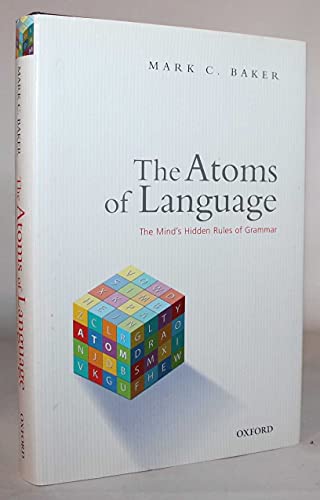Items related to The Atoms of Language: The Mind's Hidden Rules...

Synopsis
Human languages are strikingly different from each other, and also strikingly the same. One of the most indecipherable codes used in World War II was Navajos speaking their native language. Yet the Navajos were able to translate messages to and from English quickly and accurately. This shows that, for all their differences, languages must have a strong common denominator. Linguistic research is discovering that, in spite of the differences among human languages, the underlying rules that form them are virtually identical. Just as a small number of discrete elements (atoms) combine to form all physical substances, so a small number of discrete factors combine to form languages as varied as English, Japanese, Mohawk, and Hixkaryana. All sentences in all languages are built following a common 'recipe', called Universal Grammar. That recipe contains a finite number of choice points, called parameters, which interact with each other in complex ways. As a result, the shapes of phrases and sentences in languages look completely different, even though the underlying rules that form them are almost identical. In this fascinating and illuminating book, Mark C. Baker shows that these parameters can be gathered together systematically into a 'Periodic Table of Languages' that defines the structure of all natural languages. He also discusses some implications of these ideas for our understanding of the origins of human language and the value of preserving linguistic diversity.
"synopsis" may belong to another edition of this title.
About the Author
Mark C. Baker received his Ph.D. in Linguistics from MIT in 1985. After teaching at MIT from 1985-1986, he became a professor at McGill University, where he taught from 1986 to 1998. Since 1998 he has been a professor in the Department of Linguistics and the Center for Cognitive Science at Rutgers University. He is an expert on African and Native American languages, having studied Mohawk, Edo, Chichewa, Winnebago, Nupe, Kinande, and Mapuche, as well as Spanish and Urdu. He lives in New Jersey with his wife and three children.
"About this title" may belong to another edition of this title.
US$ 7.45 shipping from United Kingdom to U.S.A.
Destination, rates & speedsBuy New
View this itemUS$ 16.64 shipping from United Kingdom to U.S.A.
Destination, rates & speedsSearch results for The Atoms of Language: The Mind's Hidden Rules...
The Atoms of Language: The Mind's Hidden Rules of Grammar
Seller: WorldofBooks, Goring-By-Sea, WS, United Kingdom
Hardback. Condition: Very Good. The book has been read, but is in excellent condition. Pages are intact and not marred by notes or highlighting. The spine remains undamaged. Seller Inventory # GOR002922617
Quantity: 3 available
The Atoms of Language: The Mind's Hidden Rules of Grammar
Seller: Green Ink Booksellers, Hay-on-Wye, POWYS, United Kingdom
Hardcover. Condition: Very Good. Dust Jacket Condition: Very Good. - Dustwrapper spine slightly faded and edges of text block lightly toned - Minor shelfwear - Previous owners name to front free endpaper - Otherwise Clean bright tight book in untorn dustwrapper - 276 pages. Seller Inventory # 639449
Quantity: 1 available
The Atoms of Language: The Mind's Hidden Rules of Grammar
Seller: AproposBooks&Comics, London, United Kingdom
Hardcover. Condition: As New. Seller Inventory # 060325/vicbethking/56465
Quantity: 1 available
The Atoms of Language: The Mind's Hidden Rules of Grammar.
Seller: Kloof Booksellers & Scientia Verlag, Amsterdam, Netherlands
Condition: very good. New York :Basic Books, 2002. Hardcover. Dustjacket. 288 pp. - Whether all human languages are fundamentally the same or different has been a subject of debate for ages. This problem has deep philosophical implications: If languages are all the same, it implies a fundamental commonality--and thus mutual intelligibility--of human thought.We are now on the verge of solving this problem. Using a twenty-year-old theory proposed by the world's greatest living linguist, Noam Chomsky, researchers have found that the similarities among languages are more profound than the differences. Languages whose grammars seem completely incompatible may in fact be structurally almost identical, except for a difference in one simple rule. The discovery of these rules and how they may vary promises to yield a linguistic equivalent of the Periodic Table of the Elements: a single framework by which we can understand the fundamental structure of all human language. This is a landmark breakthrough both within linguistics, which will herewith finally become a full-fledged science, and in our understanding of the human mind. Condition : very good copy. ISBN 9780198606321. Keywords : LiNGUISTICS, Seller Inventory # 279254
Quantity: 1 available
The Atoms of Language: The Mind's Hidden Rules of Grammar
Seller: Mooney's bookstore, Den Helder, Netherlands
Condition: Very good. Seller Inventory # 9780198606321-2-2
Quantity: 1 available
The Atoms of Language: The Mind's Hidden Rules of Grammar
Seller: SAVERY BOOKS, Brighton, East Sussex, United Kingdom
Hardcover. Condition: Very Good. Dust Jacket Condition: Very Good. HARDBACK IN JACKET 2002. Clean & tight. No inscriptions. Jacket is not torn. Jacket is now under clear removable covers. Dispatched ROYAL MAIL FIRST CLASS with TRACKING next working day or sooner securely boxed in cardboard. ref h55. The Atoms of Language: The Mind's Hidden Rules of Grammar. Seller Inventory # 043351
Quantity: 1 available
The Atoms of Language: The Mind's Hidden Rules of Grammar
Seller: Revaluation Books, Exeter, United Kingdom
Hardcover. Condition: Brand New. 288 pages. 9.10x6.30x1.00 inches. In Stock. Seller Inventory # zk019860632X
Quantity: 1 available

